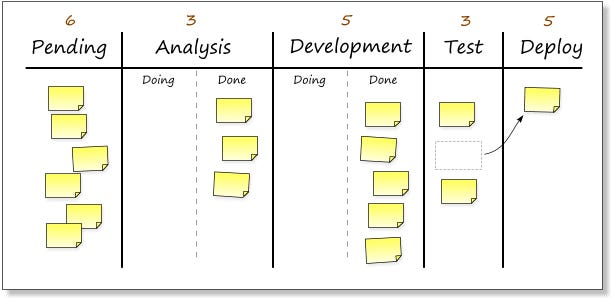Product-Market Fit - It Can Make or Break You
The state of the global economy can be oversimplified by the relationship between supply and demand. The same rule applies for start-ups. A successful business idea needs to provide SUPPLY (a product that properly addresses a customers’ needs with few/no alternatives) to a DEMAND (companies’ need to solve a large pain point they have). Success comes when enough customers adopt the product and can promote business growth and profitability. This is what we refer to as product-market fit (PMF).
Product-market fit is especially crucial for SaaS products, where it is expected that users will use the product on a recurring basis in their daily work to solve a business pain point or create efficiency, and it will likely become ingrained in their daily workflows.
We find that a leading factor of start-up deaths is a company's inability to achieve product-market fit (PMF). “Product-market fit means being in a good market with a product that can satisfy that market.” - Mark Andreessen
Establishing your product-market fit isn’t easy, therefore, this month’s leadership piece, we’re going to dive into some strategies to help you get there. We will be going over:
- Leveraging the Lean methodology to systematically find PM
- Tactical suggestions on how to use the Lean during the pre-product stage
The Lean Product Process is a simple, iterative process that acts as a guide for entrepreneurs to articulate, test, and revise any key hypothesis on how to improve product-market fit. The process outlines 6 steps:
Determine the Ideal Client Profile (ICP)
Identify Customer Needs
Define Product Value Proposition
Specify Minimum Viable Product (MVP) Scope & Features
Create a MVP (Prototype)
Test MVP with Customers
Let’s dig in.
The Digging In
I. Determine Ideal Customer Profile (ICP)
The first step is to identify the right customer segment by capturing the key customer attributes below. Outlining the ideal customer will make it easier to identify, align on, and validate the target customer. These personas will likely evolve as you get more data via conversations, focus groups, research, etc. With time, your ideal customer base will become a lot more apparent.
Once you’ve outlined these personas, it’s important to understand and evaluate the needs of your target market.
What are the largest problems these users face?
How does your product/service solve that problem? (i.e. cost savings, automation, improving quality, strengthen customer relationships, etc)
How do you successfully communicate the value your product will provide to these customers? How does that vary from persona to persona?
How do you reach out to this group? (i.e. conferences, social media, ads, etc)
How do you narrow your ICP to focus on the users that need your product the most? (i.e. for businesses - industry, company size, revenue maturity//for customers - value set, age range, location)
II. Identify Customer Needs
When building a product, it’s important to create hypotheses around how your customer is using the product and validate it in your customer discovery process.
A good way to capture customer needs is through user stories. A user story is a brief explanation of a software and its features written from the perspective of the end user.
i.e. “As a [customer type], I want to [desired action] so I can [expected benefit].
In the SaaS market, it is also important to consider the speed at which your target customer will adopt new technologies. While tech enthusiasts who are passionate about innovation may adopt cutting-edge products even if it has usability issues, more conservative users who demand ease of use, simplicity, reliability, and reasonable pricing, may not buy-in initially.
III. Defining Your Product Value Proposition
“What’s in it for me?” - Customer
A crucial factor to creating a great product is the ability to fulfill and address a major pain point for your target market. Immediately, a product needs to showcase why its core functionality outperforms other competitors in the space. To create a strong value proposition, entrepreneurs should answer the following questions:
What are the key benefits of my product?
What is unique about my product compared to competitors?
Who is my target audience?
What problem does my product solve for the customer?
Use your customer interviews to organize and rate the importance of potential product features by sectioning them out into the categories below. This way of thinking through features is called Kano Analysis. Each feature and section should also list competition in the space.
Must-haves: Features that customers expect as part of the product, given it serves a customer’s basic requirements. Must-have features are crucial to allow customers to solve their basic needs.
Performance Features: Features that add enjoyment of the product/feature equaling to increased customer satisfaction (i.e larger gas tank in car)
Delight Features: Features that are unexpected and if absent don’t cause dissatisfaction, but delight customers if present (i.e improved speaker quality)
Indifferent: Features that are neither good or bad and customers barely notice
Reverse: Features that can cause dissatisfaction and are undesired by the customers
Prioritize must-haves, performance, delight features and avoid indifferent and reverse features.
IV. Identify Minimum Viable Product (MVP) Must-Haves
While establishing the scope for your MVP, you need to determine the minimum functionality needed to validate your product. The top items that you should think of:
Establish Your Top Features
Have your team creatively brainstorming all possible features ideas that fulfill your value proposition, and rank the top five features for each benefit.
See How Users Leverage Features
Remembering the customer benefit is key, and tying user stories (a short, simple description of a feature narrated from the user’s perspectives) to feature usage is important in doing so. These stories should be independent, valuable, small, and testable. Each user story is further broken into smaller pieces of functionality called ‘Chunks’ to reduce the scope and build the most valuable parts of each feature. The smaller the “chunk”, the faster the feedback.
Identify the Largest Value Add in Your Feature Set
After User Stories are made and chunked. Developers should then assign points based on the amount of effort required. A Chunk that requires high points is broken into smaller pieces. Chunks that have high value and low development time are prioritized.
Once the team creates a list that maps each feature in the product value proposition and outlines corresponding Chunks organized by priority. First, Chunks must be selected to satisfy each Must-Have Feature and should then must be chosen to achieve key Performance Features that have been chosen for outperforming the competition. Finally, the top Delighter Feature must also be present in the MVP for customers to see why the product is superior to competitors. The chunks that are not shortlisted are added to the tentative feature roadmap for the next version. This roadmap may be changed based on customer feedback on the MVP.
V. Create a MVP or MVP Prototype
A MVP is created to test how the market and users respond to your product concept before investing in building it out. There is the option of building out a full MVP or a MVP prototype. If there are funding/time constraints, founders may want to reconsider creating a MVP prototype, a representation of your product that you create without having to build your actual product. This can span a product outline to complex wireframes. Ultimately, it's beneficial to create a prototype that can simulate the final product’s user experience in order to communicate the value of your product and collect usable feedback.
Developing MVPs through the Kanban method:
Kanban is a pull system - work is pulled into the system when the team has capacity for it, rather than tasks being assigned from the top.
The way teams implement it is by creating a Kanban board, with columns and cards
Every task occupies a Kanban card and is moved across the board as it progresses through each state. In the ideal case, tasks move smoothly between states. In reality, there are bottlenecks and impairments to flow.
A Kanban board example for software development process would look as follows:
A small note on building an MVP.
A MVP must be able to measure impact
A MVP is not the smallest product but the fastest usable product you can get out
Must be aligned to early adopters
Any discussions on quality pre-suppose PMF
The prototype must be used on real customers in the main distribution channel and with an ability to track utilization and customer actions
VI. Test MVP with customers
To prove out a MVP, it’s crucial to establish market validation. During the MVP testing period, it’s important to confirm that your testers are representative of your target market. Otherwise, you may end up misdirecting your product evolution. To achieve this:
Send a short survey to potential participants to validate that they possess attributes of your target customer. This will help you ensure that the feedback you receive is relevant and accurate.
During customer interviews, empirically measure how users are using the product or its features. This will help you gain insights into their actual behavior, identify areas for improvement, and validate that your MVP is meeting their needs.
Test your product with batches of users of around six. This approach allows you to continuously refine your hypothesis and iterate on your Minimum Viable Product (MVP)
Look for similar feedback patterns from your cohorts, prioritize significant customer concerns, and address those concerns by making immediate changes to your MVP or incorporating them into your long-term product roadmap
After testing your MVP and repeating the Lean Product Process multiple times, you’ll likely end up on either Path A or B.
PATH A
If you receive minimal negative feedback on your MVP and users find the product valuable and easy to use, congratulations! Most likely, you have found product-market-fit, validated your hypotheses, and can move forward with building out the product.
Achieving true product-market fit will be evident through low customer churn, high platform usage, and an increase in Lifetime Value (LTV). Your sales and post-sales customer success ratings are two key indicators of whether your startup has real PMF.
PATH B
If progress is stalling in your customer feedback after multiple reiterations, you may need to step back, revisit your hypotheses, and pivot. Conducting the Lean Product Process again is a good way to restart.
Regardless of the path you end up taking, it is important to keep in mind that the next step of hypotheses you make should always be informed by the previous learnings. When feedback is analyzed and root caused - your consequent decisions move the product closer to achieving PMF.
![m]x[v Capital Newsletter](https://substackcdn.com/image/fetch/$s_!NB4Z!,w_80,h_80,c_fill,f_auto,q_auto:good,fl_progressive:steep,g_auto/https%3A%2F%2Fbucketeer-e05bbc84-baa3-437e-9518-adb32be77984.s3.amazonaws.com%2Fpublic%2Fimages%2Fea20e417-cbde-447d-87d6-fde6d8b3641b_140x140.png)

![m]x[v Capital Newsletter](https://substackcdn.com/image/fetch/$s_!NB4Z!,w_36,h_36,c_fill,f_auto,q_auto:good,fl_progressive:steep,g_auto/https%3A%2F%2Fbucketeer-e05bbc84-baa3-437e-9518-adb32be77984.s3.amazonaws.com%2Fpublic%2Fimages%2Fea20e417-cbde-447d-87d6-fde6d8b3641b_140x140.png)
![m]x[v Capital's avatar](https://substackcdn.com/image/fetch/$s_!ZvwZ!,w_36,h_36,c_fill,f_auto,q_auto:good,fl_progressive:steep/https%3A%2F%2Fbucketeer-e05bbc84-baa3-437e-9518-adb32be77984.s3.amazonaws.com%2Fpublic%2Fimages%2F9891605a-7d0b-4fb7-8560-e789b2a9b4d4_500x500.png)




